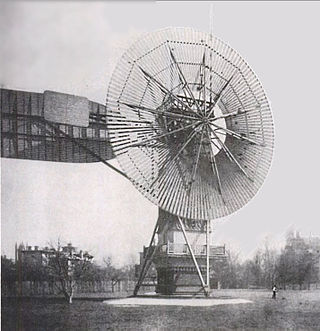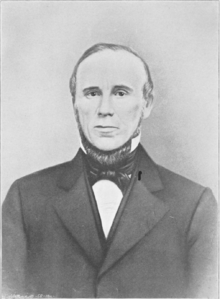
A windmill is a structure that converts wind power into rotational energy using vanes called sails or blades, specifically to mill grain (gristmills), but the term is also extended to windpumps, wind turbines, and other applications, in some parts of the English speaking world. The term wind engine is sometimes used to describe such devices.

Beloit is a city in Rock County, Wisconsin, United States. As of the 2020 census, the city had a population of 36,657 people.

A windpump is a type of windmill which is used for pumping water.

Fairbanks, Morse and Company was an American manufacturing company in the late 19th and early 20th century. Originally a weighing scale manufacturer, it later diversified into pumps, engines, windmills, coffee grinders, radios, farm tractors, feed mills, locomotives, and industrial supplies until it was purchased by Penn Texas in 1958.

The Consolidation Line was a series of diesel-electric railway locomotive designs produced by Fairbanks-Morse and its Canadian licensee, the Canadian Locomotive Company. Railfans have dubbed these locomotives “C-liners”, however F-M referred to the models collectively as the C-Line. A combined total of 165 units were produced by F-M and the CLC between 1950 and 1955.

The FM H-10-44 was a yard switcher produced by Fairbanks-Morse from August, 1944–March, 1950. The units featured a 1,000-horsepower (750 kW), six-cylinder opposed piston prime mover, and were configured in a B-B wheel arrangement mounted atop a pair of two-axle AAR Type A trucks, with all axles powered. Many H-10-44s received modifications that increased their horsepower rating to 1,200 hp (890 kW).

Wind power has been used as long as humans have put sails into the wind. For more than two millennia wind-powered machines have ground grain and pumped water. Wind power was widely available and not confined to the banks of fast-flowing streams, or later, requiring sources of fuel. Wind-powered pumps drained the polders of the Netherlands, and in arid regions such as the American mid-west or the Australian outback, wind pumps provided water for livestock and steam engines.

The Beloit water tower is a historic octagonal limestone water tower completed in 1889 in Beloit, Wisconsin.

The Davidson-Duryea gun carriage was a 3- and 4-wheeled armed armored vehicle manufactured in 1898 and 1899 for military use.

The Éolienne Bollée is an unusual wind turbine, unique for having a stator and a rotor, as a water turbine has. The eponymous invention was first patented in 1868 by Ernest Sylvain Bollée in France. A further patent dated 1885 differed mainly in two ways: First, in how the turbine was turned to face the wind and second, in an improvement which increased the flow of wind through the turbine was added. The turbines built according to the 1885 patent were commercially successful.

Bidborough Mill is a Grade II listed, house converted tower mill west of Bidborough, Kent, England. It is now incorporated into a housing development called Mill Court, on the south side of the B2176 Penshurst Road.

Keston Windmill is a grade I listed Post mill in Keston, formerly in Kent and now in the London Borough of Bromley. The mill was built in 1716 and is conserved with its machinery intact but not in working order.

Gladden Windmill is an historic windmill formerly located on Pigeon Valley Road in Napoli, Cattaraugus County, New York. The windmill was built in 1890 and is a well-preserved example of a vertical wind turbine built during the 19th century. Although no longer operational, the turbine is a rare example of wind power technology in the United States.

A panemone windmill is a type of vertical axis wind turbine. It has a rotating axis positioned vertically, while the wind-catching blades move parallel to the wind. By contrast, the shaft of a horizontal axis wind turbine (HAWT) points into the wind while its blades move at right-angles to the wind's thrust. That is, a panemone primarily uses drag whereas the blades of a HAWT use lift.

John Wallis Titt (1841–1910) was a late nineteenth-century English mechanical engineer and builder of a particular design of large wind engine.
The Fairbanks-Morse 38 8-1/8 is a diesel engine of the two-stroke, opposed-piston type. It was developed in the 1930s, and is similar in arrangement to a contemporary series of German Bombers aircraft diesels. The engine was used extensively in US diesel electric submarines of the 1940s and 1950s, as backup power on most US nuclear submarines, as well as in other marine applications, stationary power generation, and briefly, locomotives. A slightly modified version, the 38ND 8-1/8, continues in service on Los Angeles-, Seawolf-, and Ohio-class nuclear submarines of the US Navy. The 38 8-1/8 has been in continuous production since its development in 1938, and is currently manufactured by a descendant of Fairbanks-Morse, FMDefense, in Beloit, Wisconsin.

The City of Beloit Waterworks and Pump Station was built in 1885 in Beloit, Wisconsin just below a hill on top of which sits the Beloit Water Tower. It was added to the National Register of Historic Places in 1990.

The Fairbanks Flats are four apartment buildings in Beloit, Wisconsin, built in 1917 by Fairbanks Morse to house black workers arriving from the South. The flats segregated the black families, but also constitute the kernel of Beloit's black community. In 1983, they were added to the National Register of Historic Places.
Dempsters was a privately held American company that over time produced submersible pumps, windmills and wind energy systems, water systems, recycling trailers, fertilizer equipment, and accessories. Originally named the Dempster Company and then the Dempster Wind Mill Company, it was incorporated under the laws of Nebraska in 1886 as Dempster Mill Manufacturing Company. The name was later changed to Dempster Industries and again to Dempsters LLC; the company was headquartered in Beatrice, Nebraska.

















